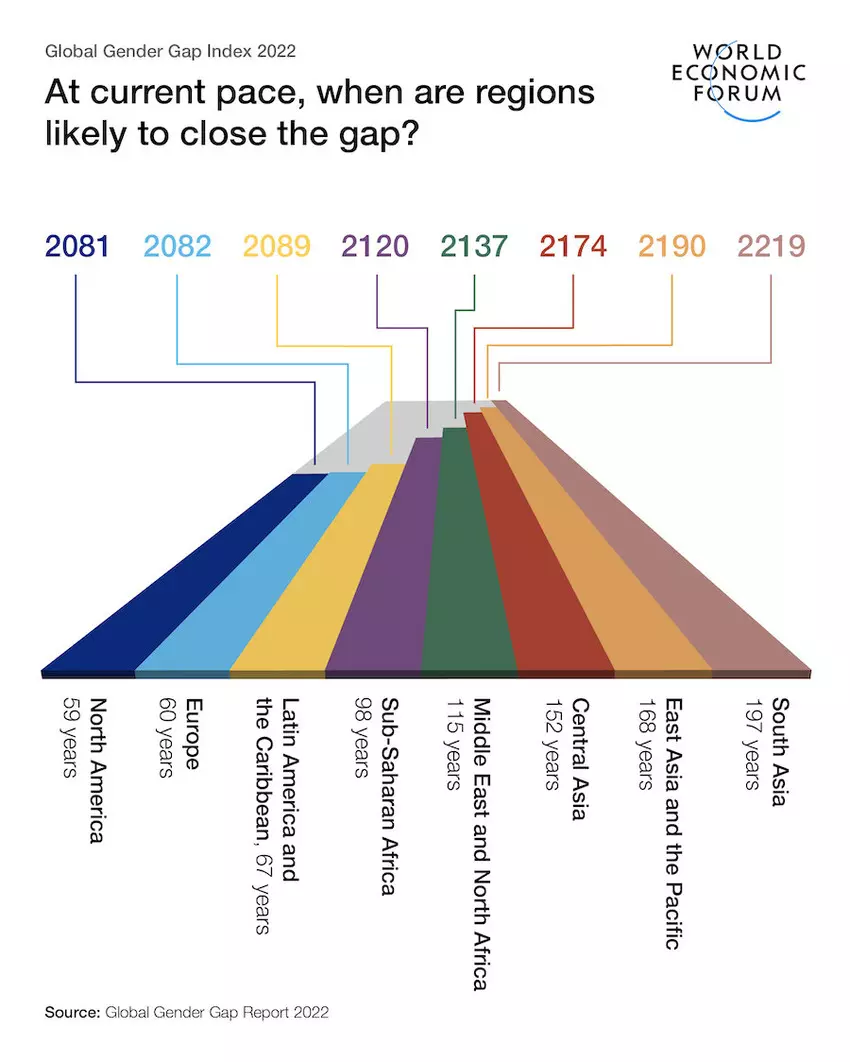July 15, 2022
GENEVA – The current recession, unlike past economic slumps that have tended to be worse for men, is disproportionately bad for women.
It comes after a period where the COVID-19 pandemic and multiple shocks in the global economy have hindered progress on closing the gender gap.
Women’s jobs were 1.8 times more vulnerable than those of men throughout the pandemic and are suffering more disruption in the subsequent economic fallout.
This year’s Global Gender Gap Report finds the global gender gap has closed by 68.1 per cent, meaning that as the global economy enters its third year of disruption, it will take another 132 years to reach gender parity.

It’s a slight improvement on the 136 years in 2021 but remains significantly higher than the 100 years recorded prior to 2020.
In other words, gender parity has been set back by an entire future generation and women today are bearing the brunt of the current economic downturn.
Why is this economic slump worse for women?
In 2022, gender parity in the labour force stands at 62.9 per cent, the lowest level registered since the index was first compiled.
Inequities in the labour force have been significantly exacerbated during the pandemic, which increased the burden of care work on women and shuttered many sectors that had high levels of female employment – like travel and tourism or retail.
At the same time, some of the sectors under greatest duress are those that employ large numbers of women – healthcare, education and other essential work.
When examining female representation in leadership positions, the Report finds that only 19 per cent and 16 per cent of leadership roles in manufacturing and infrastructure respectively are occupied by women.
However, in sectors like non-governmental organizations and education, women hold over 40 per cent of leadership roles.
While there has been progress, among Fortune 500 companies, only 8.8 per cent of the CEOs are women.
The burden of care and the growing weight of the cost-of-living crisis is falling disproportionately on women. The economic stress placed on women also contributes to increased levels of mental and physical stress, creating a vicious cycle of further personal and professional challenges.
A global stalling
Now in its 16th year, the World Economic Forum’s Global Gender Gap Report benchmarks the evolution of gender-based gaps in four areas: economic participation and opportunity; educational attainment; health and survival; and political empowerment.
It also explores the impact of recent global shocks on the growing gender gap crisis in the labour market.
This year, the report evaluated 146 countries, with Iceland (gender gap 90.8 per cent closed), Finland (86 per cent), Norway (84.5 per cent) taking the top spots.
In terms of the subindexes, the global health and survival gender gap has closed by 95.8 per cent, educational attainment by 94.4 per cent, economic participation and opportunity by 60.3 per cent, with political empowerment trailing at 22 per cent.
Each subindex showed little change from 2021 figures, pointing to a stalling of progress in a year marked by crises.
As the Report makes clear, measuring the gap and understanding its causes is the first step to closing it.

Accelerating gender parity
Gender parity is good for everyone. When human capital is diverse, companies become more creative and productive—two qualities that will continue to be essential as economies today rebuild and restructure.
Countries that integrate more women in the workforce are more productive and likely to have more inclusive and sustainable growth.
Closing the gender gap and making up for pandemic-related losses is thus critical for a faster, more robust recovery.
1. Government and business leaders must renew the focus on affected industries, including revaluing healthcare and education where so-called essential jobs need to be treated as such. This includes adequate pay and increased professionalisation to ensure proper recognition of their importance.
2. Care infrastructure investment is another area for investment. With the sector also being a job creator, there are numerous multiplier effects for economies. Complementing the focus on physical infrastructure, governments must think about care infrastructure and human capital investment as investments to enable our economies to grow.
3. A broader focus on access and the enabling environment is also critical in many parts of the world: this includes access to financial services, internet access, and expanded legal protections, ensuring that discrimination is not tolerated. Such measures are essential for developing an environment in which everyone including disadvantaged groups can thrive.

4. Leadership and role models are critical. While non-governmental organizations, education, personal services and well-being sectors tend to have above 40 per cent women in leadership positions, industries like energy, IT, manufacturing and infrastructure tend to have under 20 per cent of women in leadership roles. There is a similar situation in political leadership. A proactive approach to developing leadership pipelines in business and political organisations is necessary.
5. Finally, we need to prepare better for the future and ensure that more women are entering the industries and professions of the future – and designing our future economies. If we want our technology-driven economies to represent everybody, then we must ensure that more women are going into artificial intelligence, cloud computing, data, biotechnology and more, becoming a core part of how we design these systems for the future. Upstream efforts by businesses reaching back into high schools and colleges are critical.
To put the global economy on a more sustainable footing, embedding resilience and inclusion is key.
To grow our way out of this crisis, fresh energy, ideas and leadership are also critical. This is not the moment to roll back on gender parity – it is time to accelerate change, for all of us.
The writer is the Managing Director of the World Economic Forum. This article was contributed to the Asia News Network.


